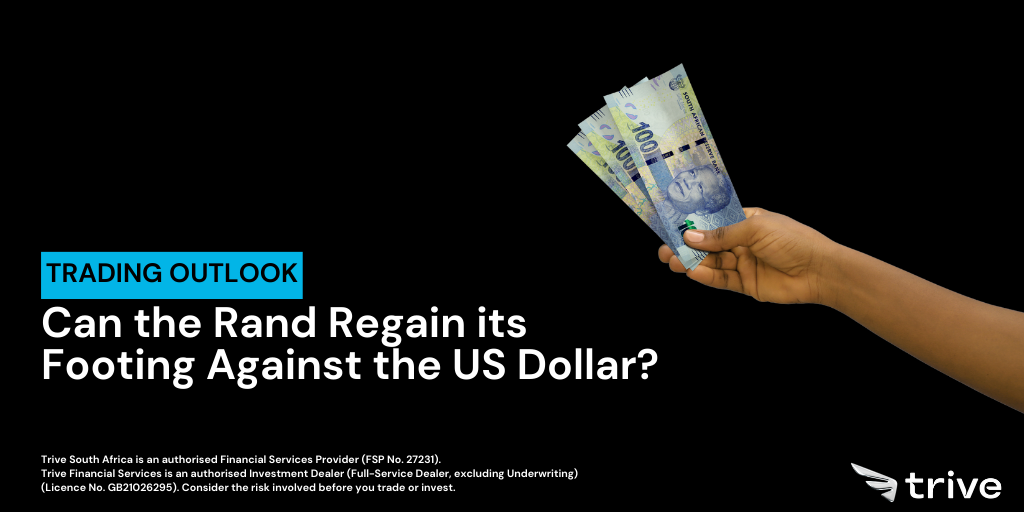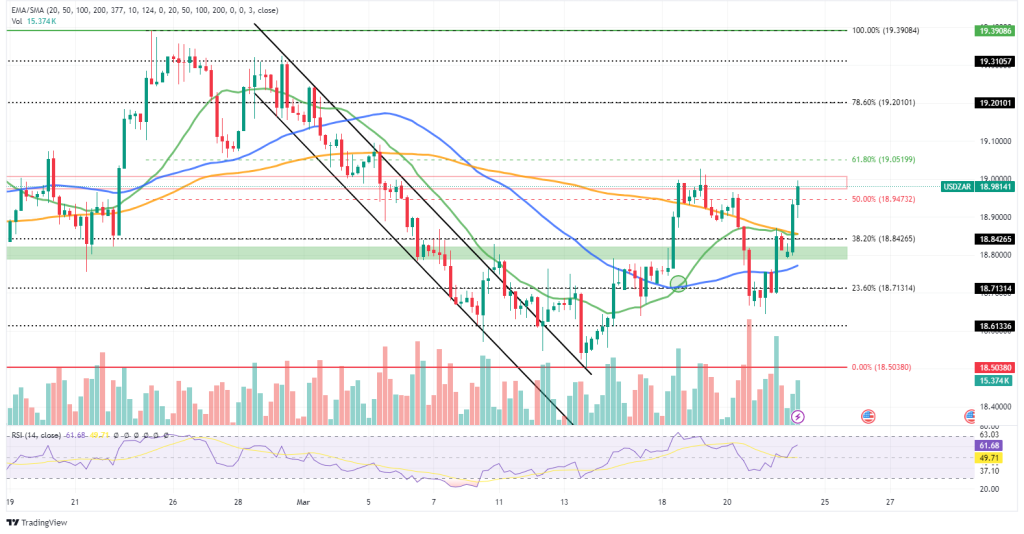
The USDZAR pair navigated a week marked by a 1.2% gain, primarily propelled by the US dollar’s strength amid lingering inflation concerns.
Recent inflation data from the US reinforced the Federal Reserve’s challenge in managing inflationary pressures, potentially delaying rate cuts. In South Africa, despite the rand’s depreciation against the dollar to approximately 18.9 per USD, the South African Reserve Bank faces stubborn inflation, leaving the central bank likely to maintain a higher interest rate stance to combat it, which could limit the greenback’s dominance against the rand. February’s headline inflation reached 5.6%, surpassing the central bank’s preferred midpoint of 4.5%, signifying prolonged rate stability in South Africa.
Market sentiment remains cautious as other central banks consider early rate cuts, contrasting the Fed’s stance. The dollar index surged to three-week highs, supported by the Swiss National Bank and Bank of England’s dovish tones, while the Bank of Japan maintains accommodative policies.
Technical
The 4-hour chart shows that the pair is currently trading at R18.9814, in a critical zone as the rand attempts to counter recent US dollar dominance. Recent movements saw price breaking above the 20-SMA (green line), 50-SMA (blue line), and the downward-sloping 100-SMA (orange line), indicating a potential shift in momentum. The upward-sloping Relative Strength Index (RSI) above 50 further reinforces this bullish sentiment.
With the RSI (55.55) upward-sloping above the 50.00 level, a sustained push above the supply zone could leave the 61.80% Fibonacci retracement level (R19.05199) as the initial resistance level of note higher. A confirmed break above the initial resistance could likely leave the 78.60% Fibonacci retracement level (R19.20101) and R19.31057 as the next levels of significance higher.
However, failure to sustain a push above the supply zone would bring the 50.00% Fibonacci retracement level into focus, with a break below the level likely to bring the 38.20% Fibonacci retracement level (R18.84265) into play in the coming sessions. A successful break below the R18.84265 price level, on significant volume, would likely bring the 23.60% Fibonacci retracement level (R18.71314) and the R18.61336 support level within reach of the bears in the short-term.

Summary
Market sentiment remains a mixed bag. The stronger US dollar on inflation worries puts upward pressure on USDZAR. However, expectations of easing South African inflation and a potentially risk-on market environment could offer support to the rand. Technically, a bullish breakout above the current resistance zone could signal a potential trend reversal, with the dollar continuing its’ recent recovery against the rand. Conversely, a breakdown below support levels could indicate continued depreciation of the US dollar.
Sources: TradingView, Trading Economics, Federal Reserve.
Piece written by Mfanafuthi Mhlongo, Trive Financial Market Analyst
Disclaimer: Trive South Africa (Pty) Ltd (hereinafter referred to as “Trive SA”), with registration number 2005/011130/07, is an authorised Financial Services Provider in terms of the Financial Advisory and Intermediary Services Act, 37 of 2002. Trive SA is authorised and regulated by the South African Financial Sector Conduct Authority (FSCA) and holds FSP number 27231. Trive Financial Services Ltd (hereinafter referred to as “Trive MU”) holds an Investment Dealer (Full-Service Dealer, excluding Underwriting) Licence with licence number GB21026295 pursuant to section 29 of the Securities Act 2005, Rule 4 of the Securities Rules 2007, and the Financial Services Rules 2008. Trive MU is authorized and regulated by the Mauritius Financial Services Commission (FSC) and holds Global Business Licence number GB21026295 under Section 72(6) of the Financial Services Act. Trive SA and Trive MU are collectively known and referred to as “Trive Africa”.
Market and economic conditions are subject to sudden change which may have a material impact on the outcome of financial instruments and may not be suitable for all investors. Trive Africa and its employees assume no liability for any loss or damage (direct, indirect, consequential, or inconsequential) that may be suffered. Please consider the risks involved before you trade or invest. All trades on the Trive Africa platform are subject to the legal terms and conditions to which you agree to be bound. Brand Logos are owned by the respective companies and not by Trive Africa. The use of a company’s brand logo does not represent an endorsement of Trive Africa by the company, nor an endorsement of the company by Trive Africa, nor does it necessarily imply any contractual relationship. Images are for illustrative purposes only and past performance is not necessarily an indication of future performance. No services are offered to stateless persons, persons under the age of 18 years, persons and/or residents of sanctioned countries or any other jurisdiction where the distribution of leveraged instruments is prohibited, and citizens of any state or country where it may be against the law of that country to trade with a South African and/or Mauritius based company and/or where the services are not made available by Trive Africa to hold an account with us. In any case, above all, it is your responsibility to avoid contravening any legislation in the country from where you are at the time.
CFDs and other margin products are complex instruments and come with a high risk of losing money rapidly due to leverage. You should consider whether you understand how these products work and whether you can afford to take the high risk of losing your money. Professional clients can lose more than they deposit. See our full Risk Disclosure and Terms of Business for further details. Some or all of the services and products are not offered to citizens or residents of certain jurisdictions where international sanctions or local regulatory requirements restrict or prohibit them.




